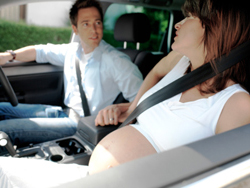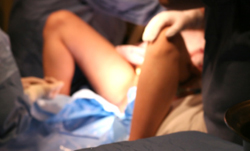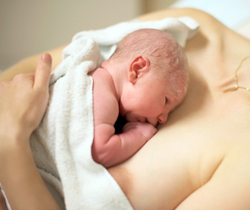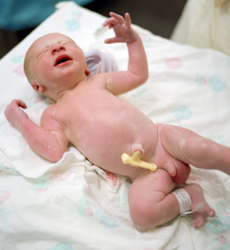CHANGES TO MUM
At week 38 of pregnancy you are most likely thinking about one thing – Labour! So how exactly does labour begin, well labour can start days or even weeks before your estimated due date in various ways such as contractions, a “show” or even your waters breaking – which can happen in any order.
Discussed in the last couple weeks of the pregnancy guide, “the bloody show” or “show” is a plug of mucous which seals the cervix during pregnancy. Prior to or during labour this mucus plug can come loose and pass through the vagina.
If it hasn’t already, it may happen any time now. Although an early indication of labour it may be several hours, days or even weeks before contractions and real labour begins.
Ruptured membranes, generally known as your waters breaking is when the fluid (membrane) that holds the baby ruptures prior to or during labour. Some times the waters breaking has no associated contractions (determined by your obstetrician) and labour may need to be induced.
With the membranes ruptured there is a risk of infection and therefore your doctor will asses if this is necessary. You should always contact the hospital when your waters break, they will ask you a few questions about it, so be sure to note the colour of the fluid.
Contractions come in two types, labour contractions and Braxton Hicks contractions (which you may have experienced previously during your pregnancy). By 38 weeks of pregnancy Braxton Hicks contractions may have increased in regularity and strength, preparing your uterus for birth.
Labour contractions become more regular, get longer, stronger and closer together. They are often said to feel like period cramps and unlike Braxton Hicks they will not go away by lying down and walking does make them stronger.
True labour contractions generally start at the top of your uterus and continue to spread over the entire uterus. They can also affect your back and pelvis.
There are said to be three stages of labour, however stage one can be broken down into three parts, plus we shouldn’t forget the pre-labour stage (consisting of the topics discussed above: Braxton Hicks and a “show”).
STAGE ONE (EARLY LABOUR)
The first stage (early labour) consists of your uterus contracting rhythmically, the cervix thinning and beginning to dilate and your baby’s head flexing onto the chest.
The contractions during this early stage of labour will be mild and like period cramps, gradually getting stronger, longer and closer together.
Usually it is safe to remain at home at this point of the pregnancy although keep in contact with your hospital, and always call prior to your arrival.
STAGE ONE (ACCELERATED PHASE – ACTIVE LABOUR)
During the accelerated phase of the first stage of labour (active labour) your contractions will establish a pattern and your cervix could be dilated anywhere from 4 to 8cms.
Contractions at this point will be much more noticeable and last up to 60 seconds, approximately 3 to 4 minutes apart.
It is a good idea to always time your contractions during labour. The midwives at your hospital will also keep a close eye on you including checking your blood pressure, temperature, pulse, contractions timing, baby’s heart rate and a vaginal examination prior to pain relief.
STAGE ONE (ADVANCED LABOUR – TRANSITION)
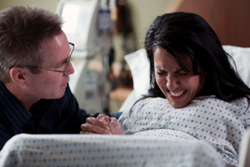
During Stage 1, Advanced Labour, You Will Experience Very Strong Contractions Lasting up to 90 Seconds.
Transition or advanced labour is when your cervix is dilated from 7 to 10cms (fully dilated) and your baby’s head is flexed and deep into your pelvis.
During this stage your uterus may even make mild pushing efforts – you may have the urge to push at the height of each of your contractions and have anal pressure from your baby.
You will experience very strong contractions lasting up to 90 seconds, unfortunately nausea and vomiting are common at this stage and are to be expected.
STAGE TWO (PUSHING)
Now it gets exciting! Your cervix will be fully dilated (10cms) by stage two and as you might have guessed, this is the pushing stage.
Your baby will rotate into your pelvis and his/her head will become more visible as your baby crowns and is born. You will have the urge to push and will be guided by the midwife and your obstetrician.
You may also experience a burning sensation and a sense of relief as your baby is born.
Your baby’s shoulders and body are born on the following contraction, after the head is born.
Your baby will be placed onto your chest immediately following the delivery for important skin on skin time.
STAGE THREE (DELIVERY OF THE PLACENTA)
The last part of labour – stage three is the delivery of the placenta as it separates from the wall of the uterus. During this stage the cord is clamped and cut.
Sometimes the father or support person likes to cut the cord, but if they are not comfortable the obstetrician does it.
An injection of oxytocin will help your uterus contract and separate the placenta. You may experience milder contractions and be asked to push.
Remember that labour can vary significantly in both time and the overall experience. Some women find the pain to be very intense, where others say that they had a fairly straight forward and pain free labour.
No matter what you experience, do what is best for you and remember that you have plenty of support!
CHANGES TO BUB
By week 38 of pregnancy your baby will weigh about 3 to 3.2kgs (or anywhere from 6 1/2 to 7 pounds). Interestingly your baby is approximately 51 cms from head to toe and in the next couple of weeks may or may not increase in length!
Your baby is still continuing to gain weight and will help to maintain his/her body temperature after birth.
While the majority of your baby is fully formed, the lungs, brain and nervous system continue to develop; as a matter of fact the lungs will be last to reach maturity.
There are so many amazing things about how a baby grows. A little fact that you may not know is that your baby’s head circumference is approximately the same size as its abdomen!
At this stage of pregnancy, your baby is continuing to accumulate lots of meconium for when your baby has its first bowl movement after birth.


